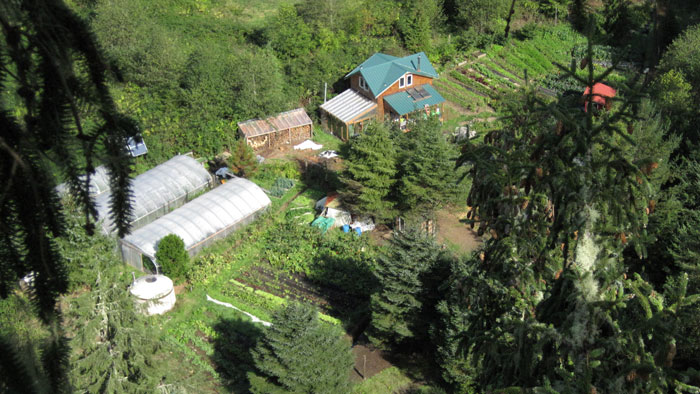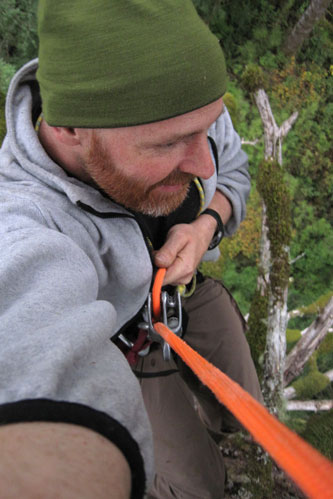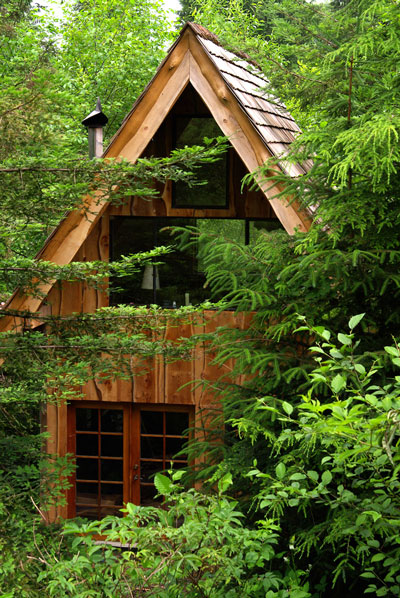a kayak named Sarah McLachlan

What's up with the climbing gear? I'll get back to that, but if you've followed this site for any length of time you've at least suspected that this isn't really a site about kayaking at all, but rather a site about living. More than making the best skin-on-frame kayaks in the world, my website is all about being an authentic free-range human being, and to share that with anyone who's bored enough to load my page once in a while.
It's been about a week since I taught my last class for the year and I must admit it's pretty darn nice to be back here in my own slice of heaven. Stepping from the car I pass by heavy pumpkins and drooping sunflowers. It's sunny and clear, a rare event this year, and rarer in the later months of any year. Everything is in a state of harvest or post harvest, chickens peck at the freshly dug potato beds and the leaves on the cabbages are absolutely huge. I walk into a greenhouse where Ginger is tending to a new batch of baby chicks, I pick a cucumber from the formerly clear plastic wall where a mat of broad leaves and vines now filters bright green light across the beds. Taking a big crispy, juicy bite I hear the shriek of a hawk and step outside to see a mating pair of redtails circling above me. They've been hanging around all summer and I've taken great pleasure in seeing them almost every day. The porch is in it's usual dissaray, overflowing with food being processed, the corners bulging with buckets and baskets of medicinal roots and drying seedpods. The kitchen is packed with mason jars filled with canned peaches, tuna, and honey from our bees. I happen to walk in just as a fly plunges into the web of my favorite kitchen guest and she emerges to wrap him in silk and plunge fangs into his eyes. Since early June an enormous garden spider has taken up residence between a houseplant and the sill on the inside of the kitchen window, bright green and pendulous, she waits patiently, growing fat in the lap of luxury.
I'm no longer naive enough to look forward to the winter as a time of repose, but it seems that I should do something leisurely before plunging into the endless toll of toil that a farm exacts. The "death mobile", while still running as strong as ever, really is going to kill someone sooner than later so we've decided to retire it in exchange for an enormous blue 4wd that our friend recently dubbed "the global warmer". My 8ft long red surf kayak drops into the bed with room to spare and I toss in the wetsuit and rumble off toward the beach. Even at noon, the lowered fall sun casts beautiful light on the landscape as I pass green fields filled with cows who will soon be living a very soggy existance.
I can see without getting out of the truck that waves are large and pushy, and not all that clean. A slight crossing of two swell systems are creating ridable, but random powerful peaks, which is not a good situation because it leaves one uncertain of the 'right spot' and leaves one exposed to the danger of being caught and thrashed by a rouge wall of water. Adding to the potential for punishment was the previous nights strong north wind dredging up enough cold water to drop water temps into the 40's. I paddle out anyways, using a rip and dose of luck to gain access to the outer breaks. I paddle cautiously, tentatively, dodging twelve foot set waves. I decide I don't relish the idea of taking a direct hit from twenty tons of ice water, not a fatal beating by any means, but not exactly pleasant either. There are nice thick waves rolling through but the longer I wait for a clean shoulder, the longer I play roulette with getting absolutely clobbered by a set wave. For the first time in a very long time, I paddle in without picking off a single wave. Just days before I'd lectured a group on how real kayaking safety meant knowing your limits and not exposing yourself to risks beyond your abilities. In this case I'm a bit irritated, but only a bit, to have to take my own advice. I peel off the wetsuit and pull on my shorts and go for a long, hard, barefoot run on the sand instead. Ankle deep seawater soaks my pants and as I splash out the miles I craft a mental plan of attack for the coming winter:
answer all emails and apologize to the fifteen or so people I've blown off in the last couple frantic months
build new chicken coup
repair the dam
bring the Belcher island kayak to George in Idaho
mill up logs
trim, plaster, stairs, and generally finish the Japanese house
design the Japanese bath house
build a hollow wooden surfboard
design, build, test, and publish the new kayak design for 2011
successfully hunt and kill an Elk
Build a small sailboat and take it sailing somewhere
teach myself video editing and make a Cape Falcon kayak rolling video
create a curriculum for next years Sustainable Technology classes on the farm
tie up loose ends before creating any new ones
write the 2010 year wrap up
(items in grey have been done since writing this)
I drive home with a head full of fresh endorphins pushing dopamine through the grey matter and casting a generally positive and hopeful hue onto my usual insane array of projects. My problem has always been that I want to do everything, and my curse is that I often get most of it done! Pulling up the driveway I glance high above me and catch a glimpse of orange rope dangling from a huge Sitka Spruce tree that overlooks our property. Thinking that I really should take those ropes down before the rains come, I glance at my watch and with less than an hour and a half of daylight, I drop a Pabst Blue Ribbon into my pocket along with my headlamp before strapping on my mud boots and a climbing harness.
Even with mechanical ascenders it takes quite a while to climb 220 feet. The six foot diameter spruce tree grows narrower as I chug skyward on what was once a very nice 9mm canyoneering rope, now pitchy and filthy in sacrifice to my tree climbing habit. After twenty hard minutes I arrive at the point of no further, pushing through the last small scratchy branches to stand ten feet shy of the absolute terminus of this massive living tree. Looking down on the canopy of smaller trees my tiny farm spreads out and I marvel at the greenhouses and rows of crops where there was nothing but brambles and brush three years ago. This vertiginous perch is a location of not just physical, but mental and emotional perspective as well. I tie in a reduntant safety line and crack open the cold beer, letting my mind and heart fan out to the horizons.

Soaking up the scenery I harbor a feeling that there is an important story here, and I'm not sure if it's the story I'm sharing or not. Every month, nine months a year, six people sign up for classes under the pretense of building an awesome skin-on-frame kayak, but for me, that's just the hook. As much as I genuinely love sharing my passion for kayaking, I take even more pleasure in bringing students over to the farm to spend an evening with wild food and homebrewed electricity. I'm used to the inevitable comments on how lucky I am to be 'living the dream' and I certainly wouldn't deny the close ties between hard work and good fortune, but what I can't seem to communicate effectively is what it took to get here.
I ponder all the branches in the road, all the places where I took the less common route for a variety of reasons ranging from injury, to poverty, to trajedy, to idealistic fervor, to my simple inability to stack numbers despite a predilection toward architecture and enginneering. What binds all these wayward paths together is that almost invariably, these were the wrong roads to take. The paths that your parents, your boss, and your accountant would frown upon, I took all those paths and over the years they've coalesced into a delightfully unusual life growing food and surfing waves here in the Oregon rainforest. A precarious, month to month existance strung together from the two least profitable ventures one can imagine: Organic farming and small boat building, but a beautiful one, and hopefully one that inspires people to live their dreams, even when that means taking a few risks.
As a lifetime denizen of some of the most spectacular places across the planet, it's ironic that living out here amongst the mostly clearcut rainforest, searching for mushrooms in the nearby woods, and hauling up crabs by kayak, I've discovered a beauty and an intimacy with nature that comes from being a participant in the natural world as opposed to merely a tourist, and somehow I've done it without becoming one of those insufferable yoga-types (apologies to insufferable yoga types). Now, more than ever I'm making those vital connections between kayaks and calories which to me shines a light on the pathway of how traditional kayaking can be relevant in the modern world. More and more I think people are seeking a deeper experience than simply hopping on a plane and zipping off to some exotic locale, but the leap that can be difficult to make is that often the less you travel the more you can find. Jamming the long flat paddle under leather deck lines while hoisting a sixty pound trap of creepy crawlies onto deck, just a breath outside the surf zone, I am thrust into a thin, but real, state of kinship with the kayak hunters of the past. Paddling back to the beach with heavy deck loads an easy surf landing becomes a nuanced dance. I walk up to my 93 year-old friend Carols' house and give her the biggest crab, because well, she's 93. The theme is always the same, connection, connection, connection. Re-connecting to the earth and each other is a feedback loop, the more you do it, the more you want to do it, and the more it prys your soul from the clutches corportate honchos who desperately want to turn you into a factory-farmed human being.
These are my hidden motives for wanting to lure you to the Oregon Coast to build a kayak with me. Sure you'll leave with a nice kayak and a belly full of whatever we're harvesting at the time, but hopefully you'll leave with something more. I'm so incredibly fortunate to meet all the interesting people who show up at my shop every year. CIA agents, oil tanker captains, veterinarians, carpenters, truck drivers, art teachers, ER doctors, students, enginneers, army helicopter pilots, bankers, computer network managers, all sorts of fascinating individuals provide me with a window into so many worlds I'd never otherwise visit. Thank you for keeping me employed and entertained. Above all, the thing I cherish the most is the laughter that frequently breaks out in my classes, moments I wish I could remember but all to often forget. One of the oddest moments that stuck with me this fall was when Hung, a vietnamese Engineering professor from Vancouver, British Columbia, made the highly unusual proclamation that his kayak would be named:
"Sarah McLachlan"
Priceless. These are the moments you miss on the road more traveled.
Well, I suppose I've rambled on long enough now, and I have no clue if any of it makes you want to come build a kayak or not. Frankly, someone like me shouldn't be allowed to own a business, I just don't have the requisite capitalist instincts. I'll just keep doing what I do, and if it all works out maybe you'll come build a boat. Thanks for reading.

- Brian
Note: If you sent me money this spring to help get my tooth fixed and I forgot to thank you, THANK YOU. Cape Falcon Kayak does not have dental insurance. If you sent me an email and I haven't replied, be persistent. I have more to do in a day than I can ever get done and I feel very guilty for letting you slip through the cracks.
Bonus Photo: Remember all those logs we salvaged out of the river with kayaks a while back? Well, this is what I built with it, a timber-framed Japanese style cabin, (thanks you to Mark Kuhlman for teaching me how to timberframe) the entire thing produced with salvage logs, milled on-site. The whole inside is stuffed with cotton insulation and covered with rough spruce lath that is currently awaiting natural plaster. The cabin is spacious and bright, despite being small, and can be heated to 80 degrees with a bucket of scrap wood in the dead of winter. The whole thing cost 6000 dollars to produce, and most of that came from leveling the surface and pouring a concrete pad, the rest is the cost for the tiny Jotul Cook Stove, and the cotton insulation. I know it's the status quo to spend a zillon dollars to build a house, but I'm not sure why people can't live like this instead. Almost every climate has some sort of nearly-free building materials.

Back to Cape Falcon Kayak